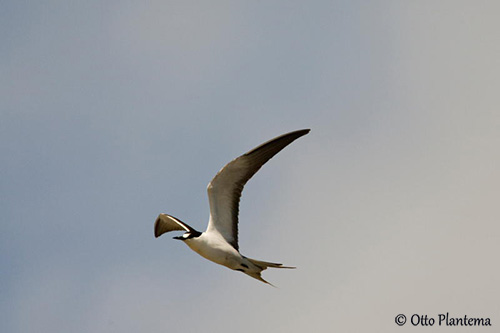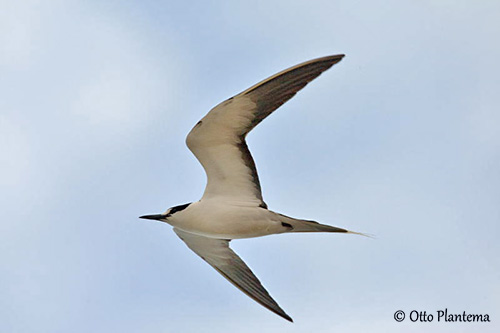
REPRODUCTION OF THIS SPECIES:
The breeding season may occur all year round at some locations, but it is often extended.
The best information on the breeding cycle comes from the Hawaiian Islands and Johnston Atoll region.
The laying takes place 5-10 weeks after adult arrival. The first egg is laid mid-February-March, but the peak of laying is in April. The laying continues into July or August.
The nest is a shallow depression in sand, or a scrape often made by the female with the feet, while the shape of the nest is made with the breast. We can see a raised rim around the depression which is usually lined with pebbles and bits of shell, and sometimes some vegetation, especially in E Polynesia.
This species may also nests among large pieces of coral rubble forming a rim.
The female lays a single egg, rarely two. The egg is white to pale yellowish with deep chestnut markings. The incubation is shared by both adults and lasts about 30 days, varying from 24-35 days to 29-32 days, depending on the location.
The downy chicks are brooded by both parents, and fed by regurgitation. Most nestlings fledge by late July, usually 38-47 days after hatching. They may remain at the colony up to 6 weeks after the first flight. They often depend on parents for some time before to become independent.
PROTECTION / THREATS / STATUS:
The Spectacled Tern is threatened by predation by Rattus rattus on the breeding islands, especially on Midway and Kure and some other islands.
The size of the population is placed in the band 100,000/1,000,000 individuals. It is declining due to predation by rats at breeding sites.
But the Spectacled Tern is not globally threatened at the moment, and the species is currently evaluated as Least Concern.
Fr: Sterne à dos gris
Ang: Spectacled Tern – Grey-backed Tern
All: Brillenseeschwalbe
Esp: Charrán Lunado
Ita: Sterna dorsogrigio
Nd: Fijistern
Sd: söderhavstärna
Photographer:
Otto Plantema
Trips around the world
Text by Nicole Bouglouan
Sources:
HANDBOOK OF THE BIRDS OF THE WORLD Vol 3 by Josep del Hoyo-Andrew Elliott-Jordi Sargatal - Lynx Edicions - ISBN: 8487334202
OISEAUX DE MER – Guide d’identification de Peter Harrison – Editions Broquet (Canada) – ISBN-10 : 2890004090 – ISBN-13 : 978-2890004092
Birds of New Guinea: Second Edition De Thane K. Pratt, Bruce M. Beehler – Editeur: Princeton University Press, 2014 – ISBN: 0691095639, 9780691095639 – 528 pages
Gray-backed Tern Sterna lunata breeding on Anatahan, Commonwealth of the northern Mariana Islands
Pakalakala or Gray-backed Tern
Wikipedia, the free encyclopaedia
Spectacled Tern or Grey-backed Tern
Onychoprion lunatus
Charadriiformes Order – Laridae Family
INTRODUCTION:
The Spectacled Tern or Grey-backed Tern is confined to the Tropical Pacific. It breeds in Micronesia, Hawaii and Polynesia, and disperses after breeding to more distant seas. This species nests on oceanic islands and is pelagic outside the breeding season. It feeds primarily on small fish.
The Spectacled Tern is apparently monogamous, but duration and maintenance of pair bond are poorly known.
It is mainly threatened by predators on the nesting islands, especially Rattus rattus. But currently, the Spectacled Tern it not globally threatened.
DESCRIPTION OF THE BIRD:
Biometrics:
Length: 35-38 cm
Wingspan: 73-76 cm
Weight: 95-145 g
The Spectacled Tern has medium to slate-grey mantle and rump. Flight-feathers and rectrices are darker grey, and the outer web of the outermost rectrices is white. The wings are relatively short, especially with short inner wing. The tail is deeply forked.
The underparts are white, slightly washed with grey. The trailing edge and the tip of the underwing are dark grey. In flight, the white leading edge contrasts strongly with the dark upperwing.
On the head, crown and nape are black. The forehead shows a white crescent-shaped patch extending in white eyebrow-stripe above and on the rear eye. It is bordered by a black eye-line extending from the bill through the eye. This line may dip slightly behind the eye, depending on individuals.
The bill is black with bluish gape and vinaceous tongue. The eyes are dark brown. Legs and webbed feet are black.
Male and female are similar.
The juvenile has less defined streaky head-pattern. It has scaly appearance due to the pale fringes of the upperpart feathers. The tail is shorter.
RANGE:
The Spectacled Tern breeds in Micronesia, Hawaii and Polynesia. But outside of Hawaiian Islands, the breeding colonies are poorly documented in most of Pacific.
In Micronesia, it is found on the northern Marianas, Wake, Johnston, and northern Marshall Islands.
In Hawaii, the largest colonies are on Lisianski with about 17,500 pairs. Other locations are Nihoa, Laysan, Necker and Gardner Pinnacles where it nests close to the Sooty Tern. On the other Hawaiian Islands, the colonies are smaller and are established on Midway, French Frigate Shoals, Pearl and Hermes Reefs, Kaula, Kure and E of Oahu on Moku Manu, the latter with about 25 pairs.
In Polynesia, the colonies are established on the Phoenix, Line, Society, Tuamotu and Marquesas Archipelago.
Following the breeding season, a part of the population disperses to more distant seas, SW to Palau, the Solomon Islands, S to Fiji and Samoa, E to Clipperton Island, and SE to the Tubuais, Pitcairns, Easter Island, and Salas y Gómez.
There are also two accepted records of single birds from New Zealand, from the Kaipara Harbour (February 1999) and Taranaki (January 2002).


HABITAT:
The Spectacled Tern breeds on atoll islets and coral islands, just above sea-level. But it also occurs on higher volcanic islands, up to 300 metres of elevation.
This species usually prefers sandy or rocky islands with low herbaceous plants and shrubs, and along vegetated edges bordering open areas.
The colonies of the Spectacled Tern are often established at the edge of colonies of Sooty Tern, but they rarely overlap.
After breeding, it is mostly pelagic. It is usually found in highly saline waters.
CALLS AND SONGS: SOUNDS BY XENO-CANTO
The Spectacled Tern’s common call is a softer, almost plaintive version of Sooty Tern’s call. As usual, they are noisy at colonies.
The main call is a squeaky “bee-doo-bee-doo” and we can hear a range of grating alarm calls.
The most frequent call is used as advertising call, contact and recognition sound. It is also used during the aerial displays, and at nest between adults.
During aggressive interactions among conspecifics, the terns produce an intense form of this call.
The calls are given from ground, perches and in flight.
BEHAVIOUR IN THE WILD:
The Spectacled Tern feeds primarily on small fish and cephalopods living near the surface.
The tern feeds by plunge-diving and contact-dipping, plunging head first into water to depths of 100-120 centimetres.
It forages between 6 and 11 metres above water, but it also forages on land and catches prey on the wing, flying low over the vegetation and dipping suddenly to capture moths. Some small lizards are also taken and swallowed head first in flight.
This species may forage by night and at dusk too.
The Spectacled Tern is a colonial nester and is apparently monogamous, but more information is needed.
At the beginning of the breeding season, display flights in flocks are reported, with the birds swirling together over potential breeding sites.
The aerial displays are not described, but both mates circle each other on the ground while their wings are drooped whereas the wrists are held away from the body. The neck is stretched upwards and the hind crown feathers are raised. The bill points downwards and away from partner. The mates circle each other and sometimes reverse the direction.
Another display shows both mates on the ground with their heads close together. While crouching, they low head and breast near the ground and rapidly nod head up and down.
These displays alternate with others and copulation. The pair wanders from site to site while displaying and engaging in nest-building behaviour while calling. The male also performs courtship feeding to the female, both during courtship and incubation. The copulation takes place on the ground, but also on rocks or other perches.
The Spectacled Tern is partly sedentary around its nesting islands. However, some populations disperse from October through February SW to Palau, the Solomon Islands, S to Fiji and Samoa, E to Clipperton Island, and SE to the Tubuais, Pitcairns, Easter Island, and Salas y Gómez.
But the migration routes are unknown.
During the flight, the Spectacled Tern appears to move up and down with slow, rowing wingbeats. Compared to the flight of the Sooty Tern, the flight of the present species is more direct, graceful and buoyant, with more rapid wingbeats. It alternates flapping and gliding.